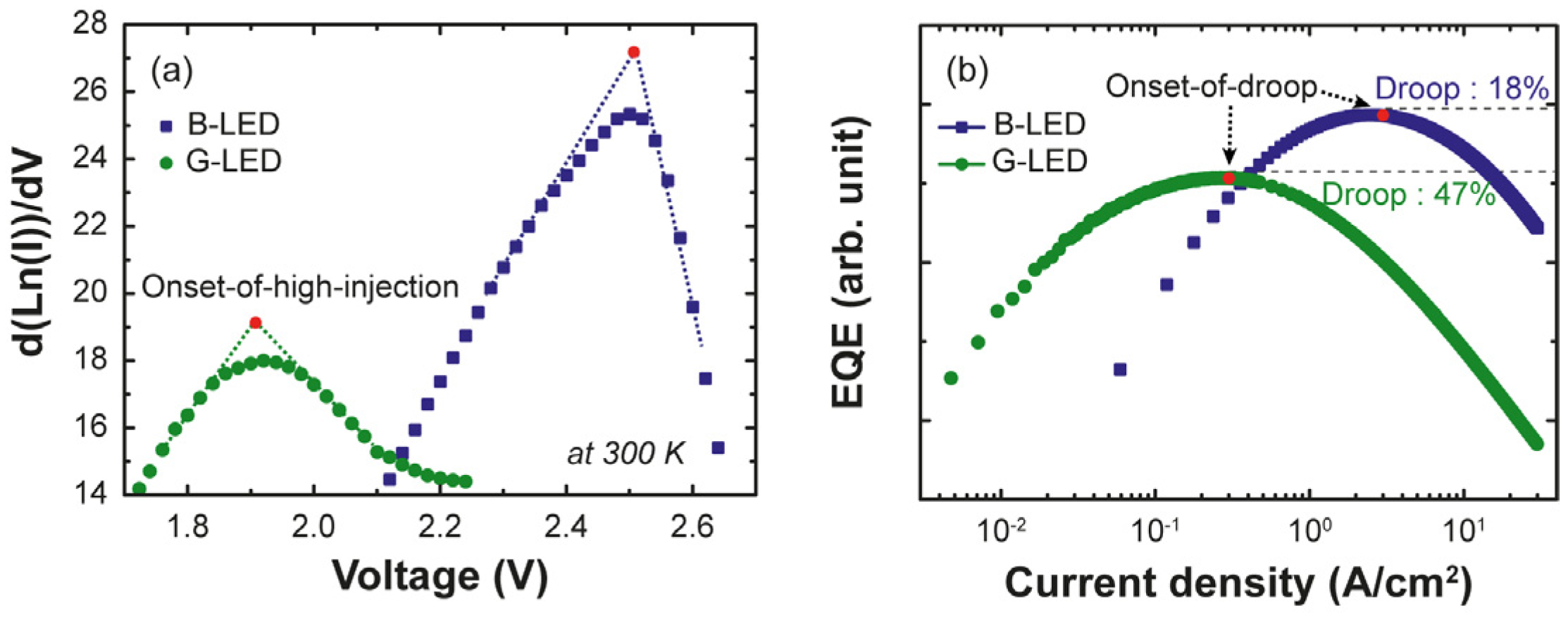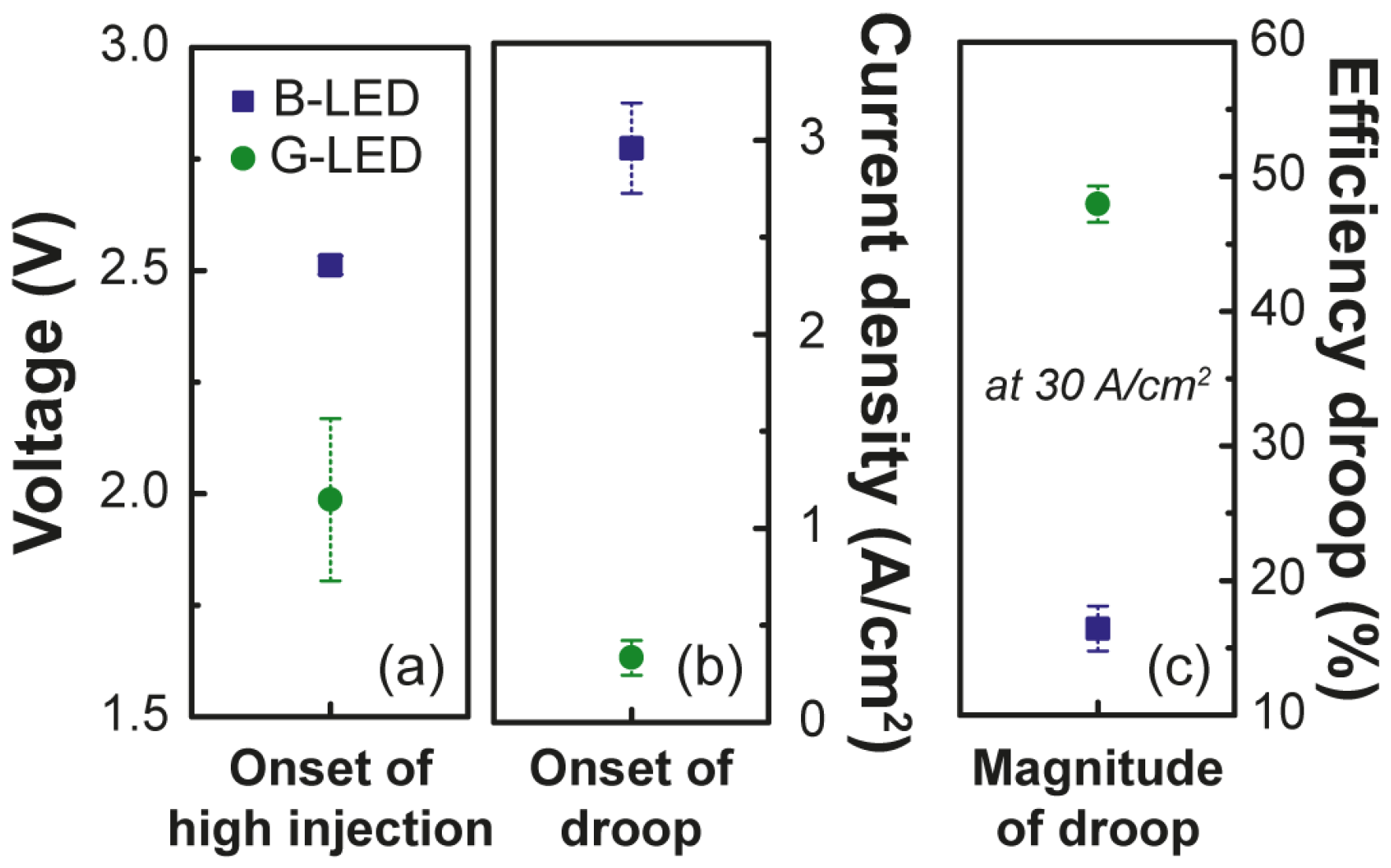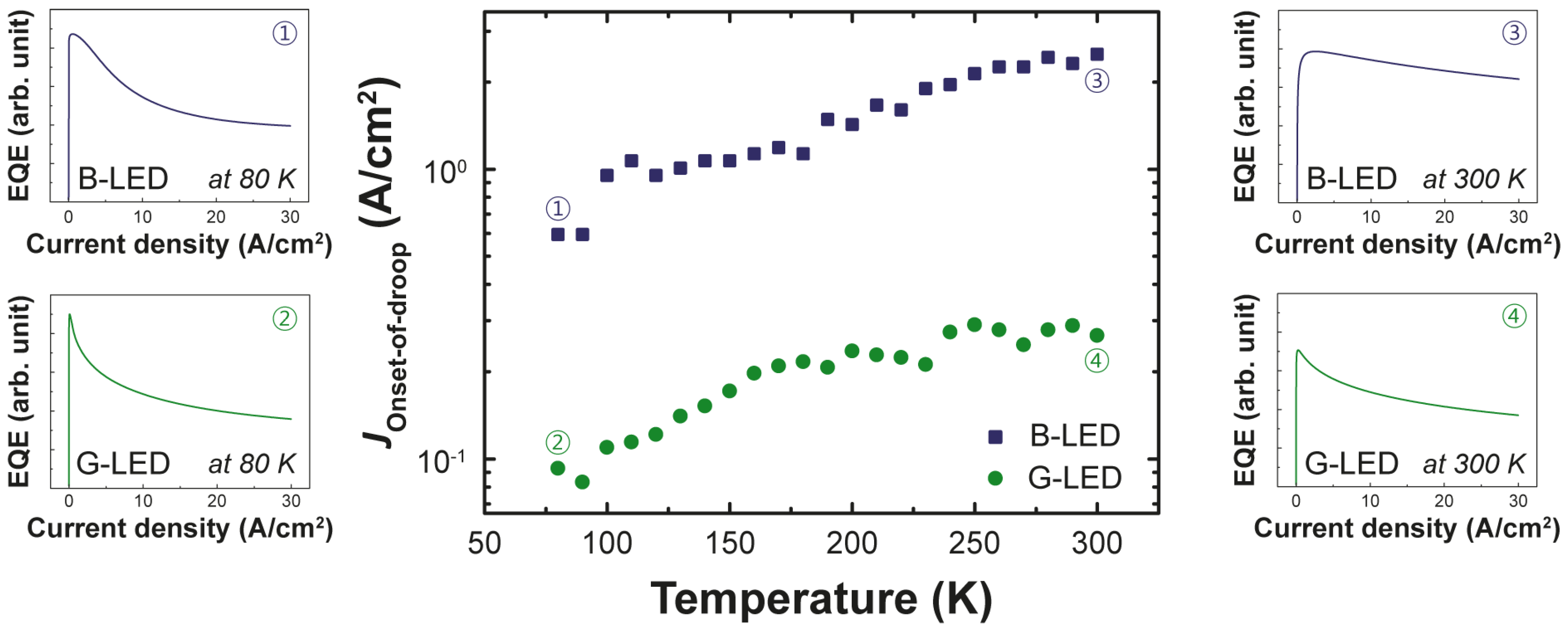The Effect of Imbalanced Carrier Transport on the Efficiency Droop in GaInN-Based Blue and Green Light-Emitting Diodes
Abstract
:1. Introduction
2. Experiment
3. Results and Discussion
4. Conclusions
Acknowledgments
Author Contributions
Conflicts of Interest
References
- Monemar, B.; Sernelius, B.E. Defect related issues in the “current roll-off” in InGaN based light emitting diodes. Appl. Phys. Lett. 2007, 91, 181103. [Google Scholar] [CrossRef]
- Meng, X.; Wang, L.; Hao, Z.; Luo, Y.; Sun, C.; Han, Y.; Xiong, B.; Wang, J.; Li, H. Study on efficiency droop in InGaN/GaN light-emitting diodes based on differential carrier lifetime analysis. Appl. Phys. Lett. 2016, 108, 013501. [Google Scholar] [CrossRef]
- Shen, Y.C.; Mueller, G.O.; Watanabe, S.; Gardner, N.F.; Munkholm, A.; Krames, M.R. Auger recombination in InGaN measured by photoluminescence. Appl. Phys. Lett. 2007, 91, 141101. [Google Scholar] [CrossRef]
- Iveland, J.; Martinelli, L.; Peretti, J.; Speck, J.S.; Weisbuch, C. Direct measurement of Auger electrons emitted from a semiconductor light-emitting diode under electrical injection: identification of the dominant mechanism for efficiency droop. Phys. Rev. Lett. 2013, 110, 177406. [Google Scholar] [CrossRef] [PubMed]
- Wang, J.; Wang, L.; Zhao, W.; Hao, Z.; Luo, Y. Understanding efficiency droop effect in InGaN/GaN multiple-quantum-well blue light-emitting diodes with different degree of carrier localization. Appl. Phys. Lett. 2010, 97, 201112. [Google Scholar] [CrossRef]
- Kim, M.-H.; Schubert, M.F.; Dai, Q.; Kim, J.K.; Schubert, E.F.; Piprek, J.; Park, Y. Origin of efficiency droop in GaN-based light-emitting diodes. Appl. Phys. Lett. 2007, 91, 183507. [Google Scholar] [CrossRef]
- Lin, G.-B.; Meyaard, D.; Cho, J.; Schubert, E.F.; Shim, H.; Sone, C. Analytic model for the efficiency droop in semiconductors with asymmetric carrier-transport properties based on drift-induced reduction of injection efficiency. Appl. Phys. Lett. 2012, 100, 161106. [Google Scholar] [CrossRef]
- Zhang, M.; Bhattacharya, P.; Singh, J.; Hinckley, J. Direct measurement of auger recombination in In0.1Ga0.9N/GaN quantum wells and its impact on the efficiency of In0.1Ga0.9N/GaN multiple quantum well light emitting diodes. Appl. Phys. Lett. 2009, 95, 201108. [Google Scholar] [CrossRef]
- Scheibenzuber, W.G.; Schwarz, U.T.; Sulmoni, L.; Dorsaz, J.; Carlin, J.-F.; Grandjean, N. Recombination coefficients of GaN-based laser diodes. J. Appl. Phys. 2011, 109, 093106. [Google Scholar] [CrossRef]
- Hader, J.; Moloney, J.V.; Pasenow, B.; Koch, S.W.; Sabathil, M.; Linder, N.; Lutgen, S. On the importance of radiative and Auger losses in GaN-based quantum wells. Appl. Phys. Lett. 2008, 92, 261103. [Google Scholar] [CrossRef]
- Calciati, M.; Goano, M.; Bertazzi, F.; Vallone, M.; Zhou, X.; Ghione, G.; Meneghini, M.; Meneghesso, G.; Zanoni, E.; Bellotti, E.; et al. Correlating electroluminescence characterization and physics-based models of InGaN/GaN LEDs: Pitfalls and open issues. AIP Adv. 2014, 4, 067118. [Google Scholar] [CrossRef]
- Schubert, M.F.; Xu, J.; Kim, J.K.; Schubert, E.F.; Kim, M.H.; Yoon, S.; Lee, S.M.; Sone, C.; Sakong, T.; Park, Y. Polarization-matched GaInN∕AlGaInN multi-quantum-well light-emitting diodes with reduced efficiency droop. Appl. Phys. Lett. 2008, 93, 041102. [Google Scholar] [CrossRef]
- Xu, J.; Schubert, M.F.; Noemaun, A.N.; Zhu, D.; Kim, J.K.; Schubert, E.F.; Kim, M.-H.; Chung, H.J.; Yoon, S.; Sone, C.; Park, Y. Reduction in efficiency droop, forward voltage, ideality factor, and wavelength shift in polarization-matched GaInN/GaInN multi-quantum-well light-emitting diodes. Appl. Phys. Lett. 2009, 94, 011113. [Google Scholar] [CrossRef]
- Meyaard, D.S.; Lin, G.-B.; Shan, Q.; Cho, J.; Schubert, E.F.; Shim, H.; Kim, M.-H.; Sone, C. Asymmetry of carrier transport leading to efficiency droop in GaInN based light-emitting diodes. Appl. Phys. Lett. 2011, 99, 251115. [Google Scholar] [CrossRef]
- Zhao, H.; Liu, G.; Zhang, J.; Arif, R.A.; Tansu, N. Analysis of internal quantum efficiency and current injection efficiency in III-nitride light-emitting diodes. J. Display Technol. 2013, 9, 212–225. [Google Scholar] [CrossRef]
- Cho, J.; Schubert, E.F.; Kim, J.K. Efficiency droop in light-emitting diodes: Challenges and countermeasures. Laser Photon. Rev. 2013, 7, 408–421. [Google Scholar] [CrossRef]
- Lin, G.-B.; Schubert, E.F.; Cho, J.; Park, J.H.; Kim, J.K. Onset of the Efficiency Droop in GaInN Quantum Well Light-Emitting Diodes under Photoluminescence and Electroluminescence Excitation. ACS Photonics 2015, 2, 1013. [Google Scholar] [CrossRef]
- Yoshimoto, N.; Matsuoka, T.; Sasaki, T.; Katsui, A. Photoluminescence of InGaN films grown at high temperature by metalorganic vapor phase epitaxy. Appl. Phys. Lett. 1991, 59, 2251–2253. [Google Scholar] [CrossRef]
- Tran, C.A.; Karlicek, R.F.; Schurman, M.; Osinsky, A.; Merai, V.; Li, Y.; Eliashevich, I.; Brown, M.G.; Nering, J.; Ferguson, I.; Stall, R. Phase separation in InGaN/GaN multiple quantum wells and its relation to brightness of blue and green LEDs. J. Cryst. Growth 1998, 195, 397–400. [Google Scholar] [CrossRef]
- Romanov, I.S.; Prudaev, I.A.; Kopyev, V.V.; Marmalyuk, A.A.; Kureshov, V.A.; Sabitov, D.R.; Mazalov, A.V. Effect of growth temperature of GaN:Mg layer on internal quantum efficiency of LED structures with InGaN/GaN quantum wells. J. Phys. Conf. Ser. 2014, 541, 012083. [Google Scholar] [CrossRef]
- Oh, M.-S.; Kwon, M.-K.; Park, I.-K.; Baek, S.-H.; Park, S.-J.; Lee, S.H.; Jung, J.J. Improvement of green LED by growing p-GaN on In0.25GaN/GaN MQWs at low temperature. J. Cryst. Growth 2006, 289, 107–112. [Google Scholar] [CrossRef]
- Lee, W.; Limb, J.; Ryou, J.-H.; Yoo, D.; Chung, T.; Dupuis, R.D. Influence of growth temperature and growth rate of p-GaN layers on the characteristics of green light emitting diodes. J. Electron. Mater. 2006, 35, 587–591. [Google Scholar] [CrossRef]
- Zhou, Q.; Xu, M.; Wang, H. Internal quantum efficiency improvement of InGaN/GaN multiple quantum well green light-emitting diodes. Opto-Electronics Rev. 2016, 24, 1–9. [Google Scholar] [CrossRef]
- Akasaki, I.; Amano, H. Breakthroughs in improving crystal quality of GaN and invention of the p–n junction blue-light-emitting diode. Jpn. J. App. Phys. 2006, 45, 9001–9010. [Google Scholar] [CrossRef]
- Meyaard, D.S.; Lin, G.-B.; Cho, J.; Schubert, E.F.; Shim, H.; Han, S.-H.; Kim, M.-H.; Sone, C.; Kim, Y.S. Identifying the cause of the efficiency droop in GaInN light-emitting diodes by correlating the onset of high injection with the onset of the efficiency droop. Appl. Phys. Lett. 2013, 102, 251114. [Google Scholar] [CrossRef]
- Han, D.-P.; Zheng, D.-G.; Oh, C.-H.; Kim, H.; Shim, J.-I.; Shin, D.-S.; Kim, K.-S. Nonradiative recombination mechanisms in InGaN/GaN-based light-emitting diodes investigated by temperature-dependent measurements. Appl. Phys. Lett. 2014, 104, 151108. [Google Scholar] [CrossRef]
- Shim, J.-I.; Han, D.-P.; Kim, H.; Shin, D.-S.; Lin, G.-B.; Meyaard, D.S.; Shan, Q.; Cho, J.; Schubert, E.F.; Shim, H.; et al. Efficiency droop in AlGaInP and GaInN light-emitting diodes. Appl. Phys. Lett. 2012, 100, 111106. [Google Scholar] [CrossRef]
- Shin, D.-S.; Han, D.-P.; Oh, J.-Y.; Shim, J.-I. Efficiency droop in AlGaInP and GaInN light-emitting diodes. Appl. Phys. Lett. 2012, 100, 153506. [Google Scholar] [CrossRef]
- Lin, G.-B.; Pandit, B.; Park, Y.; Kim, J.K.; Ryu, Y.R.; Schubert, E.F.; Cho, J. Effect of a p-type ZnO insertion layer on the external quantum efficiency of GaInN light-emitting diodes. Appl. Phys. Express 2015, 8, 092102. [Google Scholar] [CrossRef]
- Lai, K.Y.; Lin, G.J.; Wu, Y.-R.; Tsai, M.-L.; He, J.-H. Efficiency dip observed with InGaN-based multiple quantum well solar cells. Opt. Express 2014, 22, A1753–A1760. [Google Scholar] [CrossRef] [PubMed]
- Lin, J.C.; Su, Y.K.; Chang, S.-J.; Chen, W.R.; Chen, R.Y.; Cheng, Y.C.; Lin, W.J. Activation energy of n-GaN epitaxial layers grown on vicinal-cut sapphire substrates. J. Cryst. Growth 2005, 285, 481–485. [Google Scholar] [CrossRef]
- Piprek, J. AlGaN polarization doping effects on the efficiency of blue LEDs. Proc. SPIE 2012, 8262, 82620E. [Google Scholar]
- Cho, J.; Park, J.H.; Kim, J.K.; Schubert, E.F. White light-emitting diodes: History, progress, and future. Laser Photon. Rev. 2017, 11, 1600147. [Google Scholar] [CrossRef]
- Kim, D.-W.; Lee, Y.-C.; Ryu, J.-O.; Kim, S.-B. Current Components and Their Temperature Dependence of Green and Blue Light-Emitting Diodes: A Quantitative Comparison. IEEE Trans. Electron Dev. 2014, 61, 1101–1108. [Google Scholar] [CrossRef]




© 2017 by the authors. Licensee MDPI, Basel, Switzerland. This article is an open access article distributed under the terms and conditions of the Creative Commons Attribution (CC BY) license (http://creativecommons.org/licenses/by/4.0/).
Share and Cite
Park, J.H.; Cho, J.; Schubert, E.F.; Kim, J.K. The Effect of Imbalanced Carrier Transport on the Efficiency Droop in GaInN-Based Blue and Green Light-Emitting Diodes. Energies 2017, 10, 1277. https://doi.org/10.3390/en10091277
Park JH, Cho J, Schubert EF, Kim JK. The Effect of Imbalanced Carrier Transport on the Efficiency Droop in GaInN-Based Blue and Green Light-Emitting Diodes. Energies. 2017; 10(9):1277. https://doi.org/10.3390/en10091277
Chicago/Turabian StylePark, Jun Hyuk, Jaehee Cho, E. Fred Schubert, and Jong Kyu Kim. 2017. "The Effect of Imbalanced Carrier Transport on the Efficiency Droop in GaInN-Based Blue and Green Light-Emitting Diodes" Energies 10, no. 9: 1277. https://doi.org/10.3390/en10091277




